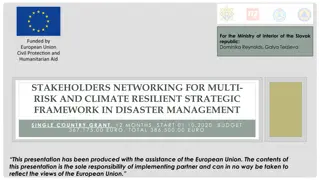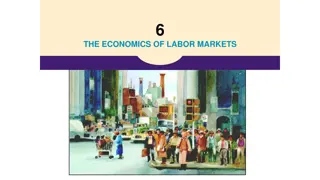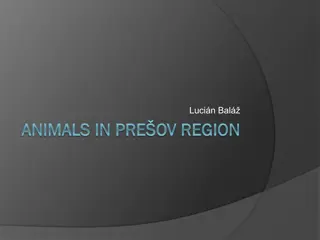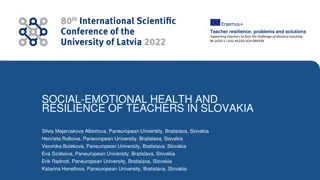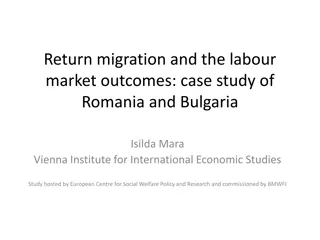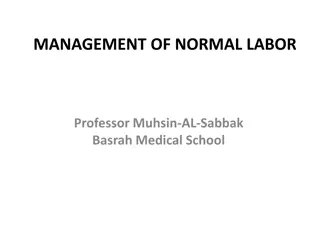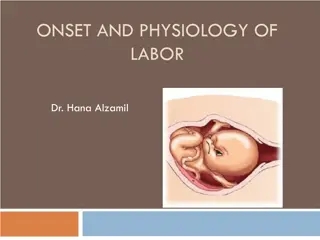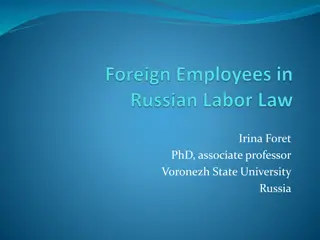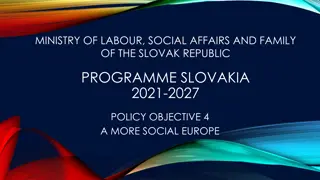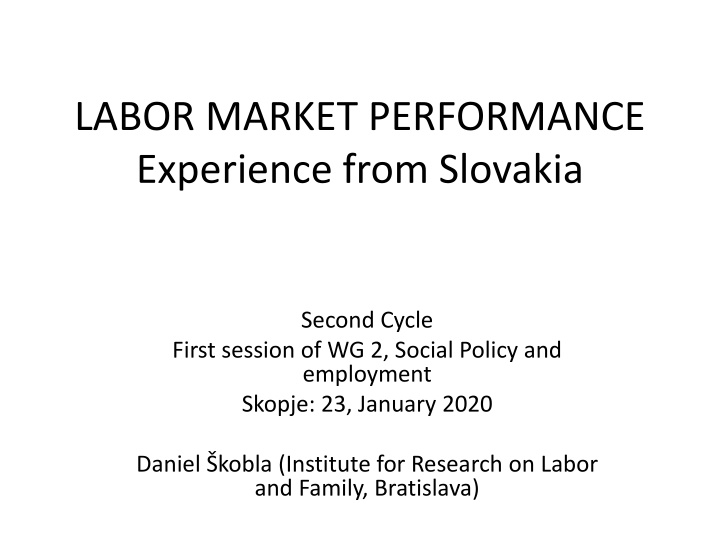
Active Labour Market Policies and Youth Guarantee in Slovakia
Learn about the implementation of Active Labour Market Policies (ALMPs) in Slovakia, funded through the European Social Fund. Discover how ALMPs aim to increase employment opportunities and support job seekers, as well as the Youth Guarantee initiative ensuring quality offers for young people. Explore key strategies and outcomes in tackling youth unemployment rates.
Uploaded on | 3 Views
Download Presentation

Please find below an Image/Link to download the presentation.
The content on the website is provided AS IS for your information and personal use only. It may not be sold, licensed, or shared on other websites without obtaining consent from the author. If you encounter any issues during the download, it is possible that the publisher has removed the file from their server.
You are allowed to download the files provided on this website for personal or commercial use, subject to the condition that they are used lawfully. All files are the property of their respective owners.
The content on the website is provided AS IS for your information and personal use only. It may not be sold, licensed, or shared on other websites without obtaining consent from the author.
E N D
Presentation Transcript
LABOR MARKET PERFORMANCE Experience from Slovakia Second Cycle First session of WG 2, Social Policy and employment Skopje: 23, January 2020 Daniel kobla (Institute for Research on Labor and Family, Bratislava)
Active labour market policies (ALMPs) The main goal of active labour market policies (ALMPs) is to increase the employment opportunities for job seekers and to improve matching between jobs (vacancies) and workers (i.e. the unemployed) In so doing ALMPs can contribute to employment and GDP growth and reduce unemployment and social benefit dependency. ALMPs help ensure that the unemployed return to employment as fast as possible and in the best possible job match, by providing them with the support they need to successfully re-enter the labour market. ALMPs are a key component of the so-called "activation strategies", encompassing the interactions between unemployment insurance/assistance systems, ALMPs and benefit conditionality.
ALMPs in Slovakia Most of the ALMP were implemented through national projects financed by the European Social Fund and co-financed from the state budget. For the funding period of 2014-2020, Operational Program Human Resources (2 628 533 420,- EUR) defined six priority axes: 1) education, 2) youth employment initiative, 3) employment, 4) social inclusion, 5) integration of marginalised Roma communities, and 6) technical facilities in communities with a presence of marginalised Roma communities In 2018, a total of 1,135,761 job seekers, job changers, or employees/jobs were financially supported with a total amount of more than 184.1 mil. euros.
The Youth Guarantee The Youth Guarantee is a commitment by all EU Member States to ensure that all young people under the age of 25 years receive a good quality offer of employment continued education apprenticeship Traineeship within a period of four months of becoming unemployed or leaving formal education. All EU countries have committed to the implementation of the Youth Guarantee in a Council Recommendation of April 2013. Countries are requested to developed their own youth guarantee program and strategy
The Youth Guarantee Funding The Youth Employment Initiative (YEI) is one of the main EU financial resources to support the implementation of Youth Guarantee schemes. It was launched to provide support to young people living in regions where youth unemployment was higher than 25. The Youth Employment Initiative exclusively supports young people who are not in education, employment or training (NEETs), including the long-term unemployed or those not registered as job-seekers. It ensures that young people can receive support within four months of leaving school or becoming unemployed. Typically, the YEI funds the provision of apprenticeships traineeships job placements further education leading to a qualification
The Youth Guarantee in Slovakia Slovakia presented a Youth Guarantee Implementation Plan in April 2014; this was included in the National Reform Program Slovakia is eligible for the Youth Employment Initiative because: Young people still represent a large share of the unemployed (app. 17 % in 2018). Additionally, the share of young people neither in employment nor in education and training (NEET) remains slightly above the EU average (12 % vs EU 11 % in 2016, age 15-24). The unemployment rate of low-skilled youth continues to be very high (47 % vs EU 26 %; 2018). (In order to implement YEI in Operational Programme Human Resources there is a specific Priority Axis 2 Youth Employment Initiative 72 175 259,- EUR).
Good practice 1 REPAS+ and KOMPAS+ The key aim is to support the employability of young jobseekers by preparing them for the labour market through either retraining (REPAS+), strengthening key competencies (KOMPAS+), or education grants to acquire new professional knowledge. Young jobseekers choose from publicly available retraining or competence courses and submit an application to Labour Office. Labour Office conclude an agreement with the young jobseeker to provide a financial contribution which covers the duration of the course. At the end of the course, participants receive a certificate of attendance and relevant qualification(s). This evidence allows young jobseekers to showcase the relevant competences/skills to make the next step into the labour market. Labour Office reimburses the young jobseeker with the course fee, meal allowance and travel costs for each day they were present on the course.
Good practice 2 Through Work Experience to Employment Financial contributions are made to employers who create a job post for the eligible target group. A post created must be filled by the employer within 30 calendar days Supported jobs can be either full-time or part-time and last between six months (minimum) and nine months (maximum). On-the-job mentoring lasts for the first 3 or 6 months. During this period, employees acquire theoretical and practical skills After completion of the on-the-job mentoring, there is a work experience period during which employees strengthen their practical skills.
Good practice 2 (continuation) The measure s financial contributions cover: Employee mentoring costs (i.e. the mentors wages) are covered up to a maximum EUR 81 per month per mentored employee. Up to 95% of the total labour costs of the mentored employee, with a maximum of EUR 649 per month for a full-time position. Up to EUR 62 for other necessary costs (i.e. equipment related to the mentoring and work experience)
Good practice 3 Contribution to support job creation in the first regular paid employment The Slovakian Labor Office provide a financial contribution to employers who create a job post for young jobseekers. The financial contribution is a percentage (dependant on region) of costs incurred by the employer. The eligible costs incurred by the employer include: cost of wages, public health insurance, social security contributions, pension contributions. Employer must retain the job post for at least half of the agreed employment period. For example, if an employer receives a contribution for eight months, the job must be maintained for at least another four months
Problems 1 the provision of offers is rarely timely and their monitoring and assessment is weak. Structural labour market weaknesses persist. The rate of participation in active labour market policies is still low and their upskilling component remains limited. Low-skilled workers, the Roma community and young people continue to face high levels of unemployment, amplified by high regional disparities - inhabitants in Slovakia's eastern region have difficulties in finding employment.
Problems 2 The situation of young Roma in the labour market is particularly weak. [ .] Unemployment among Roma reaches 48 %, while only around 25 % of Roma aged 20-64 are engaged in paid work (FRA 2016). Moreover, Roma youth are at a much greater risk of becoming NEETs (65 % in 2016).
Mismatch between what companies need and what labor force can offer An increasing proportion of manufacturing companies in Slovakia report difficulties in hiring people with the right skills, for instance in the automotive sector.
Vocational education and training in Slovakia Slovakia has a strong VET tradition, with about 70% of all upper secondary learners participating in VET programmes. Being among the most open economy in the EU and with a high employment share in manufacturing cars and electronics, its economy relies heavily on vocationally skilled people. Nevertheless, employers signal the need for reform: to combining school and company-based learning and to ensure a better match between the type of VET programmes people choose and the skills employers need.
Vocational education and training in Slovakia The government has recently introduced a dual VET scheme. It is inspired by apprenticeship in German-speaking countries, but Slovakia s approach has unique features. The Slovak education and training system is based on the 1970s model, aimed at providing all learners with at least upper secondary education, mainly through school-based VET. The 2015 reform has recently introduced the so called: dual VET providing work-based learning in companies based on contracts with individual learners. Companies take responsibility for attracting young people and for the on-the-job part of the scheme based on contracts with individual learners and their VET schools. Most VET programmes are provided at upper secondary level
Incentives for enterprises the legislation stimulates companies to offer VET learners contracts on future employment. Companies were offered tax exemptions for costs of learner meals, accommodation, travel, mandatory medical and psychological examinations, and provision of equipment. A new VET Act (61/2015) redefined these incentives to make VET more attractive for companies: (a) tax exemption for certified companies that train VET learners reduces training costs by 22%; (b) companies also receive a tax bonus of EUR 1 600 or 3 200 for each learner depending on the hours (200 or 400) of training provided per year;
VET governance Self-governing regions are responsible for maintaining public secondary VET schools and for regulating inflow of learners in their territory. The education ministry supports schools by providing regulations for content, pedagogy, and staff qualifications. Initial VET, regardless of school ownership, is subsidised from the State budget through per capita financing
Problems 3 While the interest of employers in dual Vocational Education &Training is growing, the scheme does not seem to be sufficiently attractive to young people or to certain schools. Targeted efforts to raise awareness of the benefits of dual VET among young people in compulsory education and their families are insufficient. Insufficient interest from the side of schools (only app. 100 schools involed) There is a need for more direct involvement of companies and social partners in guidance and communication activities. Innovative schemes to make professions more attractive are insufficiently developed. The practice already in place in some companies, where a job guarantee is offered to young people who enter their dual VET programme, can serve as a positive example.
Thank you for your attention danielskobla@gmail.com

